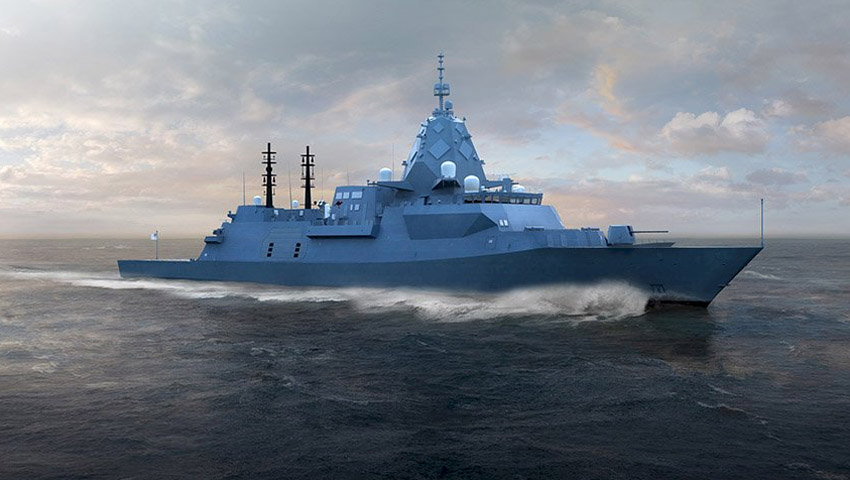Three years have passed since the federal government selected BAE Systems Maritime Australia to deliver the Hunter Class frigate program.
To continue reading the rest of this article, please log in.
Create free account to get unlimited news articles and more!
In June 2018, the federal government announced that BAE Systems Maritime Australia (BAESMA) was the successful applicant to build nine Hunter Class frigates as part of Defence’s $35 billion SEA 5000 Future Frigate Program.
Coming into service in the late 2020s, the Hunter Class – based on BAE Systems’ Type 26 Global Combat Ship, which is currently under construction for the Royal Navy – is expected to replace the Royal Australian Navy’s eight current Anzac Class frigates. It is expected that BAESMA will conclude prototyping by 2023.
Indeed, the Hunter Class frigate has been billed as one of the world’s most cutting-edge anti-submarine warships, integrating leading ISR, communications and weapons systems from across the world.
“Incorporating the leading-edge Australian-developed CEA Phased-Array Radar and the US Navy’s Aegis combat management system, with an Australian interface developed by Saab Australia, the Hunter Class will be one of the most capable warships in the world,” the Royal Australian Navy wrote.
According to Defence, the frigate will be armed with MU90 torpedos, a Mk45 Mod 4 5-inch gun, SM2 and ESSM missiles, advanced anti-ship missiles, a Mk41 Vertical Launch System and a Nulka Decoy System. And of course, the Aegis weapons system.
The Hunter Class’s Aegis Weapon System operates as the ships Combat System and manages the Australian Interface, developed by Saab Australia.
In 2019, then minister for defence Christopher Pyne announced that Raytheon had been selected as the integration agent for the Aegis system in Australia. The system, which is based on the AN/SPY-1 radar, provides 360-degree tracking in 3D, protecting ships against a range of land threats, ships, submarines, cruise missiles and even ballistic missiles.
To enhance the lethality of the ship, the frigate is also expected to be armed with an array of sensing equipment including the CEAFAR2 Radar, S2150 Hull Mounted Sonar, S2087 Towed Array and Variable Depth Sonar, electro optical sensors and electronic warfare systems alongside some 180 crew and an MH60 Romeo Helicopter. However, significant research and development is required by both Defence and the prime contractors to ensure the successful rollout of the SEA 5000 program. To support the project’s execution, the Minister for Defence Industry Melissa Price confirmed that the Commonwealth government was investing $65 million for the construction of a new testing facility to enhance the integration of critical infrastructure into the vessel. The new facility, which will be constructed at the St Kilda Transmitting Station in South Australia, will be built by Australian construction company Hansen Yuncken.
Since last year’s inaugural Defence Connect special edition, BAESMA has selected a broad array of Australian SMEs to engage with the prime on the construction phase. The total SEA 5000 program is expected to integrate 500 Australian businesses into the frigate’s supply chain.
In July, the prime selected WA-based VEEM to develop a prototype propeller blade for the frigates, following a feasibility study in 2020. The Australian SME will collaborate with Kongsberg Maritime in order to develop the prototype, with the final announcement for the propeller due in 2022.
Meanwhile, the prime tapped Lloyd’s Register to support the delivery of naval classification and certification services, in which the company will provide training support to 40 members of the BAESMA staff. It is expected that the training and certification will enable BAESMA’s supply chain to adhere to the required certification and identify areas in which the supply chain can enhance their operations.
Meanwhile, Sydney’s Burwell Technologies was engaged by the prime to undertake blast trials to test the upcoming frigates’ equipment. Earlier in the year, BAESMA onboarded three Australian SMEs to support the delivery of piping systems across the Hunter Class, which include Victorian-based Mackay Consolidated Industries, and SA-based Century Engineering and Novafast International. Meanwhile, veteran-owned Logistic Engineering Services has agreed to deliver software, training and consultancy support to the program to enhance the management of Integrated Logistic Support (ILS) data as well as technical consulting. However, the success of the Hunter Class is measured upon the capabilities that the ship will provide to the Australian Defence Force in an increasingly unstable Indo-Pacific.
Writing in Defence Connect Insight, Craig Lockhart managing director of BAE Systems Maritime Australia explains how the program is critical in protecting Australia’s future.
“Australia has no option but to get it right the first time. By around 2035, half of the world’s submarines will be operating in the Indo-Pacific region, which means the Hunter’s anti-submarine warfare capability will be extremely important to protect Australia’s interests. Delivery into service with the Royal Australian Navy when it is needed is of utmost importance,” Lockhart writes.
“That is why the Commonwealth government’s decision… to shift cut steel for the first Hunter frigate by up to 18 months is important. The decision puts into practice the lessons learned from first of class ship build programs around the world, which tells us that it is fundamental to mature the design as much as possible prior to commencing construction. It will also result in a greater build efficiency across the Hunter Program, reducing the risk of rework for each frigate and, therefore, enable schedule compression in the following years that ensures greater certainty around our delivery milestones.”
Current estimates suggest that the Hunter Class frigates will enter service from the late 2020s.
This article originally appeared in the Defence Connect maritime special edition, which can be viewed here.
Liam Garman
Editor – Defence and Security, Momentum Media

 Login
Login








